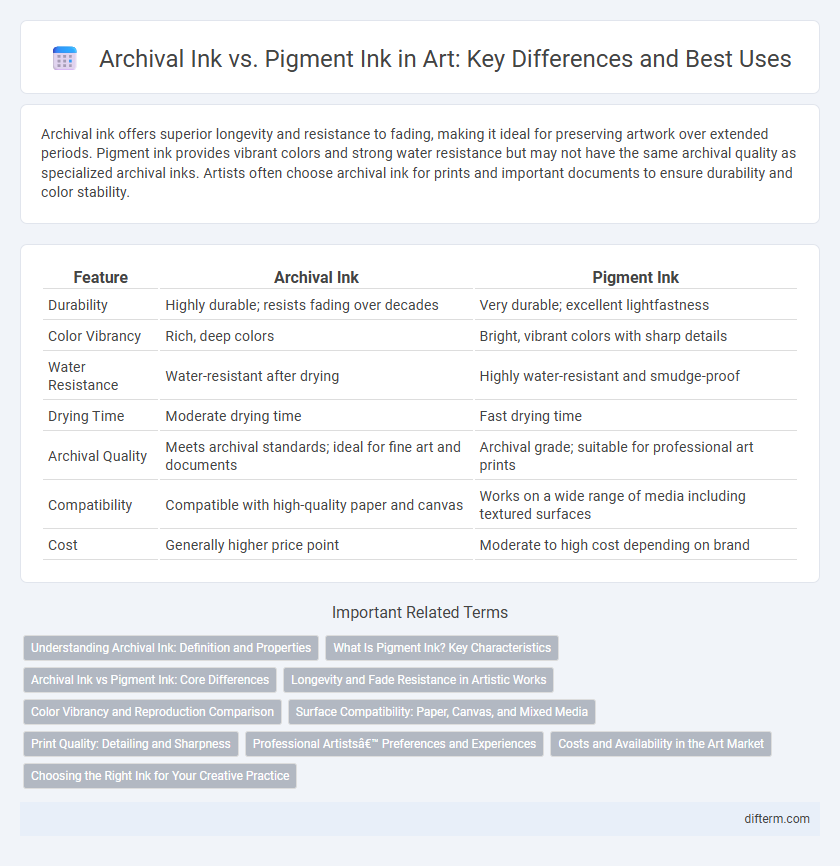Archival ink offers superior longevity and resistance to fading, making it ideal for preserving artwork over extended periods. Pigment ink provides vibrant colors and strong water resistance but may not have the same archival quality as specialized archival inks. Artists often choose archival ink for prints and important documents to ensure durability and color stability.
Table of Comparison
| Feature | Archival Ink | Pigment Ink |
|---|---|---|
| Durability | Highly durable; resists fading over decades | Very durable; excellent lightfastness |
| Color Vibrancy | Rich, deep colors | Bright, vibrant colors with sharp details |
| Water Resistance | Water-resistant after drying | Highly water-resistant and smudge-proof |
| Drying Time | Moderate drying time | Fast drying time |
| Archival Quality | Meets archival standards; ideal for fine art and documents | Archival grade; suitable for professional art prints |
| Compatibility | Compatible with high-quality paper and canvas | Works on a wide range of media including textured surfaces |
| Cost | Generally higher price point | Moderate to high cost depending on brand |
Understanding Archival Ink: Definition and Properties
Archival ink refers to a type of ink formulated for longevity, resistance to fading, and stability, making it ideal for art preservation and documentation. It typically contains pigments suspended in a water-based solution, offering superior colorfastness and waterproof qualities compared to dye-based inks. Artists and conservators prefer archival ink for creating prints and artworks that maintain their original appearance over decades without deterioration.
What Is Pigment Ink? Key Characteristics
Pigment ink consists of tiny particles that sit on top of the paper rather than soaking in, offering superior lightfastness and water resistance compared to dye-based inks. Its key characteristics include long-lasting color stability, vibrant and sharp image reproduction, and resistance to fading over time, making it ideal for archival-quality prints and fine art applications. Artists and photographers often prefer pigment ink for preserving the integrity of their work in galleries and museums.
Archival Ink vs Pigment Ink: Core Differences
Archival ink and pigment ink differ primarily in composition and longevity, with archival ink formulated to resist fading and chemical degradation over extended periods. Pigment ink consists of solid pigment particles that sit on the paper's surface, offering vibrant colors but varying resistance to water and UV exposure. Archival inks typically provide superior permanence and resilience, making them ideal for fine art prints and documents requiring historical preservation.
Longevity and Fade Resistance in Artistic Works
Archival ink is renowned for its superior longevity due to its stable chemical composition, which resists fading and degradation over decades, making it ideal for preserving artistic works. Pigment ink contains larger particles that sit on the paper's surface, offering excellent fade resistance, especially when exposed to light, which enhances the durability of fine art prints. Artists and collectors prioritize archival and pigment inks for their proven ability to maintain color integrity and detail in artworks exposed to environmental factors.
Color Vibrancy and Reproduction Comparison
Archival ink offers superior color vibrancy due to its stable dye-based formulation, ensuring rich and vivid hues ideal for fine art prints and detailed reproductions. Pigment ink, composed of larger particles, provides excellent longevity and resistance to fading but may produce slightly muted colors compared to archival inks. For high-fidelity art reproduction, archival ink enhances color accuracy, while pigment ink excels in durability, making the choice dependent on the desired balance between vibrancy and permanence.
Surface Compatibility: Paper, Canvas, and Mixed Media
Archival ink exhibits superior adhesion on a wide range of surfaces including textured paper, coated canvas, and various mixed media, ensuring long-lasting prints resistant to fading. Pigment ink provides vibrant color retention but may struggle on highly absorbent or untreated materials, often requiring primed surfaces to maintain clarity. For diverse artistic substrates, archival ink's chemical stability and compatibility make it the preferred choice for durability across paper, canvas, and mixed media applications.
Print Quality: Detailing and Sharpness
Archival ink offers superior print quality with exceptional detailing and sharpness due to its finely ground pigments and consistent flow, ensuring crisp lines and vibrant colors. Pigment ink, while also providing strong colorfastness, may show slight bleeding or less precision on highly detailed prints, affecting fine line clarity. For artworks demanding meticulous detail and long-lasting sharpness, archival ink remains the preferred choice among professional artists and printmakers.
Professional Artists’ Preferences and Experiences
Professional artists prefer archival ink for its exceptional longevity and resistance to fading, making it ideal for creating art intended to last decades or more. Pigment ink is favored for its vibrant, dense color quality and superior water resistance, which enhances the visual impact and durability of prints. Many artists report a consistent performance with archival ink in fine art prints and appreciate pigment ink's ability to maintain sharpness and color integrity over time.
Costs and Availability in the Art Market
Archival ink typically costs more than pigment ink due to its superior longevity and fade resistance, making it a preferred choice for fine art prints and limited editions. Pigment ink, while more affordable and widely available, often lacks the archival quality needed for high-value artwork preservation in galleries and collectors' markets. Availability of archival ink is generally limited to specialty art stores and professional suppliers, whereas pigment ink is easily accessible in mainstream retail outlets and online platforms.
Choosing the Right Ink for Your Creative Practice
Archival ink offers superior longevity and fade resistance, making it ideal for preserving fine art prints and important documents. Pigment ink provides vibrant, water-resistant colors with excellent color accuracy, preferred for high-quality illustrations and graphic art. Artists should evaluate the archival properties, color vibrancy, and compatibility with their chosen media to select the best ink for their creative practice.
Archival ink vs Pigment ink Infographic

 difterm.com
difterm.com